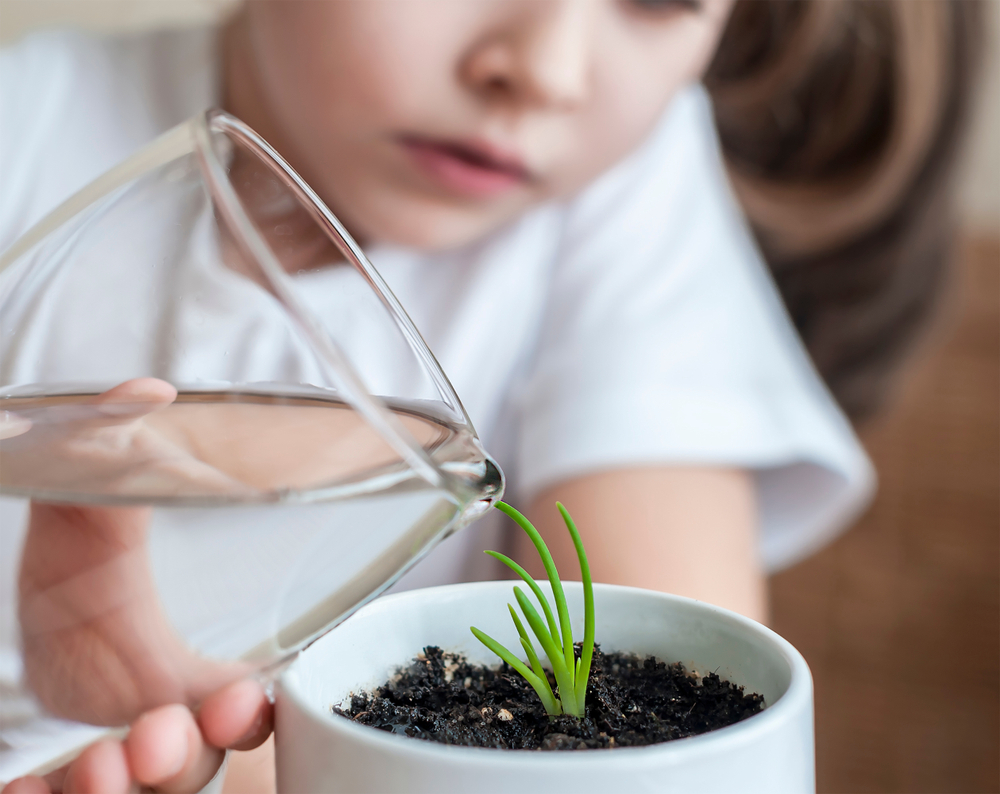Plant care activities in the Montessori classroom are some of the most enjoyable Practical Life Activities for young children.
Through caring for plants, children get a chance to help make their classroom more beautiful – and the chance to work with water. (That's always enjoyable!)
What is the point of teaching young children how to care for plants, though? What are the benefits to them?
In this article, you will learn what the Montessori plant care activity is and how to set it up. You will also learn the benefits of this beautiful Practical Life activity.

(This post contains affiliate links. Purchasing from these links costs you nothing extra, but helps with our website upkeep.)
I've included a supply list with a couple of safe plants on it down further in the article, but I want to emphasize that not all plants are safe for children.
Gardening Know How has a good list of safe plants for kids.
If you are looking for specific plants to avoid, The Bump has a good list.
What is a Montessori plant care activity?
Learning how to care for a plant is one of the Practical Life activities a small child is introduced to in a typical Montessori classroom.
Learning to care for a plant is classified as a Care of Environment activity.
Montessori classrooms and home areas are kept organized and pleasing to the eye.
The bit of color provided by plants and eye-level art helps to make these learning and living spaces even more beautiful.
Montessori recognizes that seemingly simple activities, like watering a plant, can be challenging to children, and are best presented in formal lessons, slowly and in steps.
What are the benefits of teaching young children to care for plants?
Plant care, like all Care of Environment activities, encourages young children to appreciate, care for, and enhance different aspects of their environment.
Learning to care for plants, specifically, has some unique lessons and benefits of its own.
Benefits of learning care of plants:
- Learning how to water plant
- teaches children how to wash the leaves of a plant
- teaches kids that a living thing needs water
- fine motor skills
- learning care of the environment
After a child has learned how to properly care for the plants in the classroom and at home, you may find that they notice when the plants are in need of care.
You might also observe that the child notices and appreciate other beautiful things in their environment, and may want to learn to care for those things, as well.
One thing I've observed in my own children is that their level of empathy towards plants and wildlife seemed to increase after we started doing activities with plants.
How to present the Montessori plant care activity
In a Montessori classroom, caring for a plant is generally introduced in the primary program, around the age of 3.
If you're introducing this activity at home
Supplies:
- tray
- spray bottle
- child's watering can
- indoor plant (I recommend an African Violet or a Chinese Money Plant.)
- small scissors (for extension)
- cotton balls
- apron
- small bowl
The lesson
Watering a plant
- Invite the child to join you in putting on your aprons.
- Set the plant down on the work table.
- Put the watering can, filled with water, on the table next to the plant.
- Show the child how to hold the watering can, gripping it by the handle with the thumb placed over the four fingers and the non-dominant hand bracing the can below its spout.
- Lift the can and slowly pour a small amount of water into the soil at the base of the plant.
- Invite the child to do the same, pouring a small amount at a time until water begins to flow under the plant into the saucer/base.
Cleaning a plant
- Invite the child to join you in putting on your aprons.
- Carry the plant to the table and ask the child to follow you with the tray of supplies. (cotton swabs, spray bottle, bowl)
- Tell the child what you are about to do, clean the plant.
- Using the spray bottle, spray the plant's leaves lightly with water.
- Gently wipe each leaf with a cotton swab.
- When you are through wiping the leaves, place the dirty cotton swab in the bowl.
- After the plant is clean, return it to its place.
- Return the tray to its shelf and replace the dirty cotton balls with clean ones.
Some plant care extension activities
- Flower arranging
- Pruning
Have you given a Montessori-style plant care lesson to the children in your classroom? At home?
I'd love to hear about your experience.
Did the child(ren) show more interest in taking care of their immediate and/or extended environment afterward?
If plants interest your child, planting a butterfly garden is a great project I encourage you to try.
Cheers and don't forget to subscribe!
